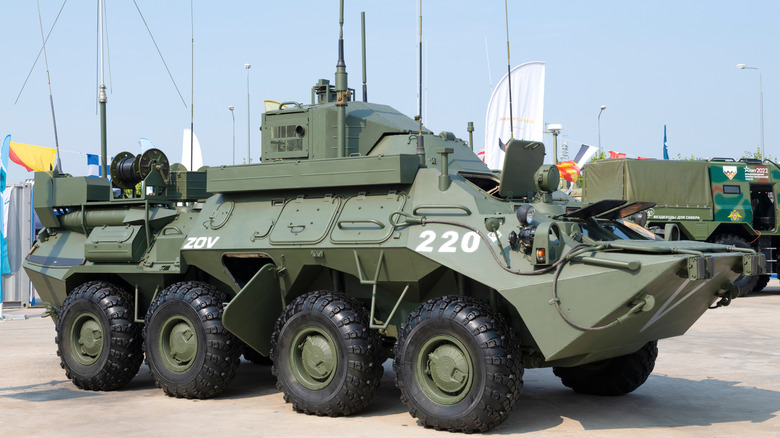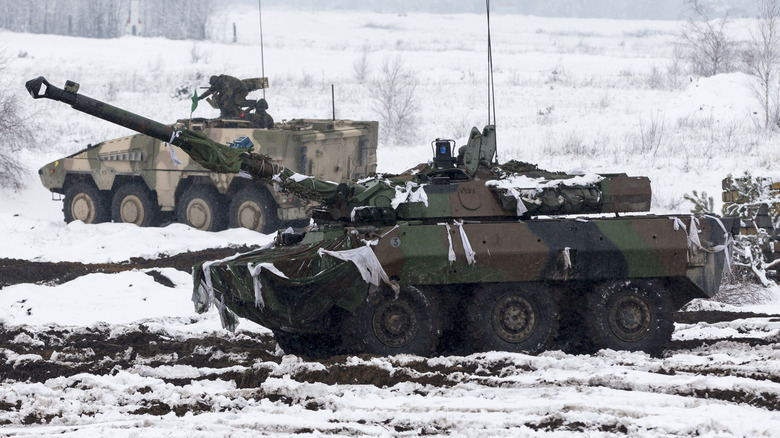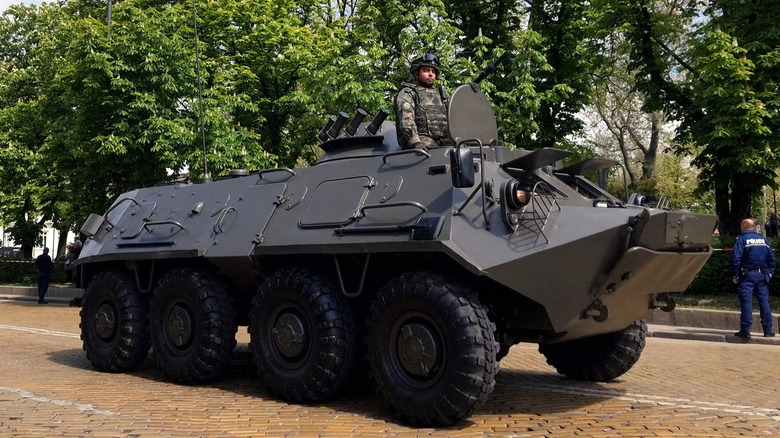What's The Difference Between A Military Armored Car And An APC?
In the era of modern warfare, there are almost too many weapons available to military factions looking to make their mark on the frontlines. While there are any number of vessels designed to bring the fight to enemies via air and sea, when it comes to a more traditional ground assault, tanks and armored vehicles are the most common tools used by military units to back up their troops on the battlefield.
There are, of course, countless variations of armored vessels even in that seemingly hyper-specific category of wartime vehicles. In fact, these days it can be difficult to distinguish a more traditional battle tank from a tracked artillery vehicle like Samsung's K9 Thunder. But even apart from those more widely recognized artillery options, there is a whole class of armored vehicles on the battlefield these days that are meant to be faster and more agile than their larger counterparts.
While many of these smaller vehicles are meant for use in combat, others have more specific uses in mind than mere war play. But given the sheer breadth of options available in the area of armored military vessels, it can often be difficult to distinguish one build from another. That's particularly true of vehicles designated as a military armored car and those designated as an APC. And yes, despite some similarities in design and function, these battlefield machines bear some stark differences. Here's a quick rundown of what sets these two classes of armored military vehicle apart.
What is an Armored Car?
While there may be some similarities in style, there is, more often than not, at least one notable difference between a military armored car and an APC, in that the former will likely be equipped with significantly more fire power. In fact, some military armored cars — sometimes also referred to as IFVs or infantry fighting vehicles — may even boast a proper gun turret like you'd traditionally see on an artillery tank. That feature sometimes makes it easy to mistake an armored car for other tank-like vehicles like the assault gun and the tank destroyer.
The primary difference between those two machines of war is that an armored car traditionally maneuvers around a battlefield on wheels instead of tracks. Of course, armored cars also tend to be smaller than your average artillery tank, which — in conjunction with the use of non-tracked wheels — makes them far more mobile on the battlefield. Combined with their low-key artillery capabilities, that maneuverability makes armored cars better equipped to navigate road ways and particularly useful during conflicts occurring on or around paved surfaces and leveled-off battlefields.
The rub when it comes to armored cars, however, is that they are generally not as heavily armored as most tanks, meaning they are far more susceptible to enemy attacks. Apart from that, the fact that armored cars don't typically have tracks means that they can more easily get stuck when tasked with traversing muddy, or otherwise deteriorated battlefields. So, there are clearly a few important tradeoffs to consider between those two battle-ready vehicles.
What is an APC?
While technological advances have led military factions to utilize fewer troops on the battlefield, modern warfare still tends to require the use of ground forces. Anytime troops on the ground make their way into a fight, the military is invariably faced with the task of transporting them from one point of conflict to the next. While large, open-aired trucks have often been employed in such endeavors, these days many military outfits utilize vehicles called APCs, or Armored Personnel Carriers.
Like most military armored cars, modern APCs tend to also get around on wheels – though tracked models have and still do exist. The key difference is that armored cars are typically intended to carry no more than a few soldiers to a battle front. In contrast, the primary purpose of an APC is to protect and transport groups of soldiers to the frontlines, then evacuate the scene while engaging with the enemy as little as possible.
For obvious reasons, this means APCs tend to be slightly larger in terms of their cargo capabilities, and are often long enough to require eight-wheels. That size allows them to transport entire infantry squads — which are traditionally composed of between four and 10 soldiers — into battle. Though they are heavily armored, APCs tend to be lighter and faster than armored cars, in part due to their general lack of heavy artillery. Historically, APCs have not carried much in the way of firepower — though, some newer builds are beefing up their on-board armaments.


